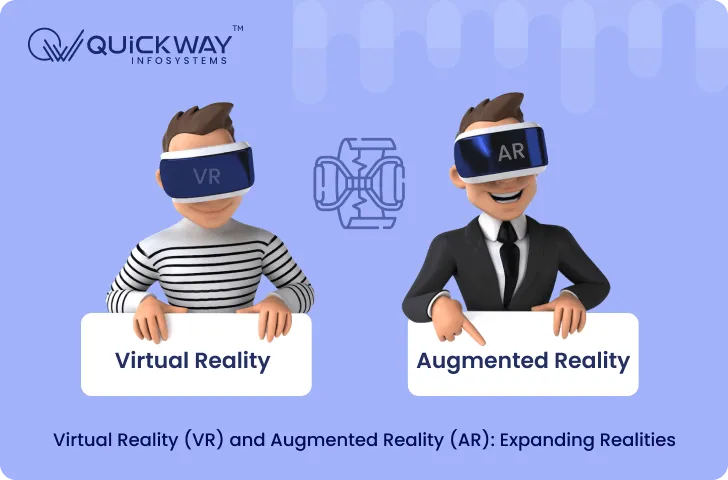Augmented reality and virtual reality are innovative technologies that either enhance or substitute a real-life environment with a simulated counterpart. Augmented reality (AR) enriches your surroundings by introducing digital elements into a live view, often utilizing the camera on a smartphone. On the other hand, virtual reality (VR) offers a fully immersive experience by replacing the physical world with a virtual simulation.
AR involves the creation of a virtual environment that coexists alongside the real environment, aiming to provide informative and supplementary data about the real world without the need for explicit searches. For instance, industrial AR applications could swiftly offer troubleshooting information when directed towards malfunctioning equipment.
In contrast, virtual reality encompasses a comprehensive environmental simulation that entirely replaces the user’s actual surroundings with a fabricated virtual world. These virtual environments are often designed to be larger and more vivid than life. For example, VR could enable a user to engage in a boxing match with a cartoon version of Mike Tyson within a virtual boxing ring.
While both augmented reality and virtual reality share the objective of introducing users to simulated environments, they possess distinct characteristics and serve varied purposes. Beyond entertainment, augmented reality is increasingly adopted by businesses due to its capacity to overlay valuable information onto real-world situations.
In the sections ahead, we will explore the workings of both these reality technologies, with a specific focus on the business applications of augmented reality.
Overview of AR and VR
What sets augmented reality (AR) and virtual reality (VR) apart?
Although both technologies involve simulated reality, AR and VR rely on disparate foundational components and cater to different user groups.
Virtual reality entails the user wearing a headset and headphones to entirely replace the actual world with a virtual realm. The aim of VR is to minimize real-world involvement and create insulation from it. Within the VR universe, virtually anything can be programmed, ranging from engaging in a lightsaber battle with Darth Vader to experiencing a meticulously designed yet entirely fictional representation of Earth. While VR has some business uses in fields like product design, training, architecture, and retail, its primary applications are concentrated in the realm of entertainment, particularly gaming.
On the other hand, augmented reality integrates the simulated world with the actual one. In most cases, users employ a smartphone or tablet screen to achieve this integration. By directing the device’s camera towards a point of interest, a live video feed of the scene is displayed on the screen. Overlays of useful information are then added to the screen, encompassing functionalities such as repair instructions, navigation assistance, or diagnostic data.
Nevertheless, augmented reality is also pertinent to entertainment scenarios. An illustrative example is the mobile game Pokemon Go, where players endeavor to capture virtual creatures while moving through the physical world.
What are some instances of augmented reality and virtual reality in action?
Augmented reality boasts a diverse array of applications, with several practical examples available for exploration today.
- Ikea Place: This mobile app enables you to visualize Ikea furniture within your own living space. It superimposes a 3D model of the furniture onto a live video feed of your room.
- YouCam Makeup: Users can virtually test real cosmetics on themselves using this app, leveraging a live selfie.
- Repair Assistance: Technicians can wear a headset that guides them through repairing or maintaining equipment, complete with visual diagrams detailing the placement and order of each part.
- Sports Enhancements: Augmented reality is harnessed to provide real-time statistics in various sports and to enhance physical training for athletes.
- Pepsi MAX Campaign: PepsiCo recently engaged in a playful stunt targeting London commuters through an augmented reality (AR) enhanced bus stop exhibit. Passersby were treated to captivating scenes including a prowling tiger, a meteor impact, and an alien tentacle snatching pedestrians off the street. Mere words cannot fully capture the essence of the experience. See it for yourself!
In addition to gaming and entertainment contexts, virtual reality finds application in the business realm:
- Architectural Design: Architects employ VR to design and allow clients to virtually explore homes before any construction begins.
- Vehicle Design: Virtual reality is increasingly utilized in designing automobiles and other vehicles.
- Training in Hazardous Environments: Workers in high-risk fields such as firefighting and the military use VR for training, minimizing actual risk.
The origins of virtual reality and augmented reality can be traced back to specific time periods:
Virtual reality technology started taking shape in the 1950s and 1960s, with early attempts at immersive systems. However, the concepts of both VR and AR gained traction primarily within military applications during the early 1980s. Movies like “Tron,” “The Matrix,” and “Minority Report” portrayed futuristic takes on the evolution of these technologies.
In 1993, the Sega VR headset marked an initial mainstream foray into VR, though it never reached the market. The Oculus Rift in 2010 marked the first successful consumer VR headset, although these devices remain relatively pricey and are mainly of interest to gaming-oriented users.
Augmented reality emerged as a distinct field around 1990, and it gained public attention in 1998 when TV broadcasters began overlaying a yellow line on football fields to illustrate the distance to a first down. Over the subsequent decade, both military and consumer applications were developed, including apps for fighter jet cockpits and consumer products embedded with QR codes that triggered short 3D videos when scanned with a cellphone.
In 2014, Google introduced Google Glass, an AR headset controlled by voice and touch gestures. Although met with skepticism due to privacy concerns, Google repositioned the project for enterprise use after an initial suspension.
How is Augmented Reality finding utility in the realm of business?
Presently, augmented reality is predominantly harnessed for business and enterprise applications. Several noteworthy examples include:
- Design and Construction: Among the most prevalent and rewarding applications of AR in business, designers employ augmented reality to visualize potential products or structures in real-world settings. They can virtually refine existing products without any physical interaction.
- Maintenance and Repairs: AR technology offers guidance to technicians performing repairs, upgrades, and maintenance tasks across a spectrum of items, ranging from industrial machinery to entire buildings. Technicians can access detailed instructions, often visual in nature, overlaid onto the machinery itself, eliminating the need for printed manuals or online references.
- Training and Education: Enterprises utilize AR for immersive employee training experiences, facilitating a comprehensive understanding of novel products and concepts. This approach is also being adopted by educational institutions.
- Healthcare: AR has extended its influence to surgical settings, where overlays provide surgeons with crucial procedural steps, patients’ vital data, and more.
- Retail: From virtual makeup try-ons to simulated changing rooms, businesses employ AR to provide shoppers with an enhanced, contemporary augmented reality encounter while shopping.
- Technology: Products like Splunk AR are introduced in major utility companies to enhance responses during power outages and grant comprehensive insights into their data infrastructure.
- Marketing: AR concepts integrated into packaging, point-of-sale materials, and even billboards offer businesses a fresh and markedly memorable means to directly engage with customers.
What components constitute an augmented reality system?
Augmented reality systems can vary in implementation, but they generally consist of the following essential components, classified into hardware and software categories.
Hardware Components:
- Processor: Augmented reality demands substantial processing power to generate and position imagery in a manner that makes it seem integrated into the real environment. Processors can be integrated into mobile devices or wearable gadgets.
- Display: Imagery in AR is generated and displayed in various ways, including:
- Mobile handheld devices: Smartphones or tablets serve as common platforms, with live video imagery captured by the device’s camera and overlaid with AR data.
- Wearable devices: Smart glasses like Google Glass and others feature a display only visible to the wearer, offering an overlay of AR information.
- Automotive HUDs: Heads-up displays project information onto a car’s windshield, enabling drivers to see data without diverting their gaze.
- Camera: A fundamental sensor, the camera captures live video that is then processed by the processor to overlay AR data. The camera itself doesn’t process digital information but provides the necessary visual input.
- Other Sensors: Various sensors facilitate AR operation, including accelerometers, digital compasses, GPS, microphones for audio input, and LiDAR for precise distance measurement.
- Input Devices: Interaction with AR systems necessitates diverse input methods. Options include mobile device touchscreens, voice recognition for verbal commands, and gesture recognition translating hand motions into actions.
Software Components:
- Image Registration: Software analyzes photographic input of the surroundings, determining real-world coordinates, object placement, foreground-background distinctions, and points of interest. This process maps and categorizes the physical environment.
- 3D Rendering: With the real world mapped, the 3D renderer overlays augmented reality elements onto the live image. Virtual objects are generated and positioned accurately within the environment. Augmented Reality Markup Language (ARML) defines object location and appearance.
- Content Management: Back-end technology maintains a database of virtual objects and 3D models for efficient retrieval and integration into the AR experience.
- Interface: The interface acts as an intermediary between users and the augmented reality environment, offering interaction and visualization capabilities, whether in video games or technical tools.
- Development Toolkits: A variety of software technologies, both open source and proprietary, provide developers with frameworks to create AR applications on their chosen platforms.
- Incorporating these hardware and software elements, augmented reality systems offer a dynamic interface between the real world and digitally enhanced experiences.
How does augmented reality function on mobile devices?
If you come across an augmented reality application today, it is likely to be in the form of a mobile app for smartphones. Almost all smartphone users have access to a multitude of AR apps on both iPhone and Android devices, eliminating the need for any supplementary hardware. The essential software functionalities required for AR are integrated into the device’s operating system.
In a typical scenario, a user of an AR app initiates the application on their mobile phone or tablet. The design of most AR apps is quite straightforward. The user simply points the device’s camera at a subject of interest and awaits the app to enrich the screen with additional contextual information. This could encompass various elements such as navigation guidance, celestial body identification, or even dance move instructions.
Obstacles and Future Prospects
The journey of AR and VR is still in its nascent phase, with an extensive path of development ahead before these technologies attain widespread adoption. Some of the frequently cited challenges encompassing technology and business domains include:
Technology Challenges:
- Limited Mobile Processing Capacity: Mobile devices have constraints on processing power, and depending solely on a desktop or server is not practical. The dilemma lies in expanding mobile processing capabilities or offloading work to cloud resources.
- Constrained Mobile Bandwidth: While cloud-based processing could potentially mitigate mobile processing limitations, the current pace of mobile data bandwidth in most areas isn’t adequate for real-time video processing. This situation is likely to evolve as mobile bandwidth advancements take place.
- Complex Development: Crafting an AR or VR application is intricate and resource-intensive. Development tools need to evolve to become more user-friendly, democratizing access to these technologies for developers.
Business Challenges:
- Inconvenience of VR Hardware: The act of donning a virtual reality headset and clearing a space can disrupt the user experience. Moreover, VR input devices, often resembling adapted gaming controllers, can be non-intuitive and entail a steep learning curve.
- Establishing a Viable Business Model: Beyond video gaming, many AR and VR applications are in early developmental stages, with their practicality in the business sphere yet to be proven.
- Security and Privacy Concerns: The backlash stemming from the initial Google Glass release highlighted the public’s reservations about the widespread presence of cameras and its implications for privacy. Securing video feeds and addressing potential storage concerns are pertinent issues.
Despite these challenges, substantial headway is being made to broaden the scope of both business and commercial applications for AR and VR. This progress aims to usher these technologies into mainstream acceptance.
What Lies Ahead for AR and VR?
The future for AR and VR holds great promise, with upcoming years ushering in enhanced capabilities and wider adoption. Anticipated advancements in video quality, processing prowess, mobile bandwidth, and AR/VR hardware are set to propel these technologies into the mainstream. Decreasing development costs and complexity will empower creators to delve into a broader range of possibilities. Furthermore, systems designed to monitor eye movements and facial expressions will gradually render cumbersome joysticks and controllers obsolete.
While the gaming and entertainment sectors will continue to steer this industry’s growth, AR and VR will also witness burgeoning practical applications. In the realm of virtual reality, this encompasses fully simulated surgeries, where surgeons operate within a virtual environment while robotic systems execute the actual procedures. Within the augmented reality domain, the concept of “Mirrorworld” aims to virtually replicate the physical universe on a 1:1 scale, enabling the virtual exploration of diverse locations.
Education is likely to experience a transformation toward virtual models on AR and VR platforms, both within academic settings and the corporate world. Additionally, retailers will increasingly leverage AR applications to enhance virtual shopping experiences, gradually diminishing the significance of physical storefronts.
Summing up:
AR and VR are on the cusp of significant growth. While they currently occupy niche spaces, their maturation promises impressive potential. As innovative VR games and AR navigation aids gain traction, consumers are becoming more open to exploring future applications of these technologies. Industries are also embracing AR, finding utility in areas ranging from design to maintenance to healthcare.
As we peer into the future, the emergence of novel tools driven by AR and VR holds great anticipation.



